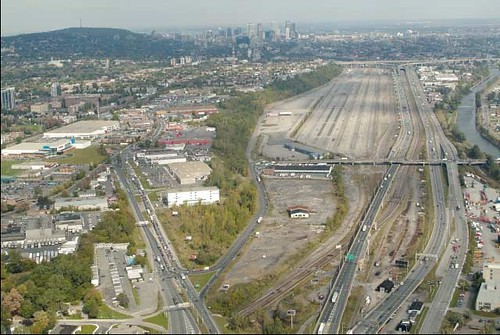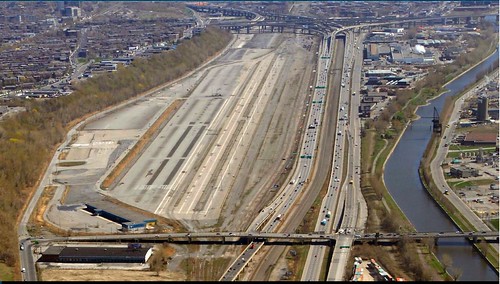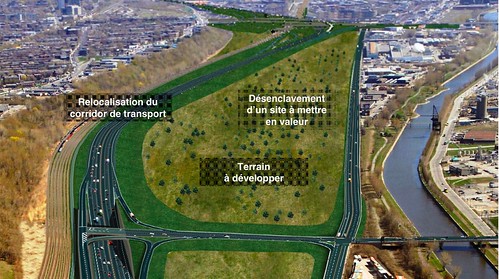As the ramifications of the mega overhaul planned on the Turcot Interchange become clearer, it appears that NDG residents will be affected as well. Originally overlooked by MTQ officials – who initially only planned public hearings in the southwest borough – residents had the opportunity to make their case before officials last night.

The primary issue on concern for those who brought their questions to the floor was that of the Falaise St. Jacques. While once extensively used as a trail by Iroquoian peoples prior to European contact, it became an obstacle during Montreal’s twentieth century development, a dead space which a sprawling train yard served only to reinforce. But with a paucity of green space in NDG, residents are trying to re-value this natural feature. Designated as a protected green space by the City of Montreal in 2004, it has nevertheless remained largely inaccessible for most residents. Recently, blogs like Waking Turcot Yards and Exploring the Falaise St. Jacques – as well as local environmental groups – have reignited a public interest in this space.

Transports Quebec ensured that their plan to move the Autoroute 20 up against the bottom of the bluff would not compromise the eco-territory, but the plan will see a once-protected (if neglected) space become a sponge for noise and pollution. Also, the addition of extra railway tracks alongside the 20 (see below) would render the bluff even more inhospitable. Many residents who approached the microphone urged the MTQ’s representatives to shift the 20 closer to the Lachine Canal, or simply leave it where it is (at ground level, not suffering from the deterioration that plagues the towering overpasses).

Maybe I’m just cynical, but it seems the MTQ’s rationale for the highway hugging the bottom of the cliff is clear: this land stands to be profitably developed. The Ministry has trumpeted the opportunity to increase the value to this disused area, but has done so with a fairly narrow definition of “value”. Early indications are that the 100-odd hectares that stand to be opened up will likely house various light industries (single story, aluminum clad buildings). There must be something better.
Peter McQueen, Green Party candidate for NDG advocates leaving the 20 where it is and building a sustainable residential community that integrates the bluffs into a park for public recreation. The architectural firm Béïque, Legault & Thuot have put forward a plan that would see the return of Otter Lake – part of a natural waterway that predated the CN rail yards – and a mix of usages including environmental education, recreation, residential and commerce.
Concerned NDG residents are pushing hard. The question is: has the province learned anything in the last 40 years?

4 comments
The South West usually is going to get screwed by mega projects. I believe the highway should stay where it is and the Falaise be part of a sustainable corridor that actually creates a natural link between NDG and the South West – and with a major hospital being built up on the hill it just makes sense to create an all inclusive environment around there.
I would also prefer that the Turcot Interchange remain elevated. The interesting thing about elevated freeways, their raison d’etre actually, is that things can pass under them. The plan they have now would almost completely cut off Saint Henri from whatever happens there – residents would have to risk walking along the train tracks to get over.
My wackiest ideas category: If the Turcot Interchange has to come down I would like to see at least one strand of it preserved. It would make one hell of a bike path and without motor vehicles on it would last forever. Also elevated freeways are architecture and as such can be considered to be art and these very sculptural works should be preserved under the notions of cultural heritage. There! I ‘ve said it, :P!
I have trouble accepting noise as a real problem for NDG residents. The top of the bluff is occupied by low-density commerce and industry before it gets into the residential area. More people live closer to the Décarie expressway.
It seems to me the falaise was identified as one of the last natural growth areas. This should be preserved, and one of the best ways of doing is, unfortunately, is to *not* turn it into a park. Look at the environmental damage the park on Mount Royal suffers from nothing worse than footfalls. One thing that should be taken into consideration, however, is the impact that air pollution from the autoroute would have on the plant-life on the falaise.
I’s like to see something along the lines of BLTA’s design, perhaps also with some recreation of the petite rivière Saint-Pierre to meet Lachine canal. Personally I’d envision something with more residential housing, but Montreal is in need of greenspace.
@Neath: a “natural link”? It’s a bluff. It’s a natural barrier! And the hospital is on the other side of Décarie and Turcot; it won’t be any more linked than before.
However, I’m all for some aspect of the interchange being preserved in an artistic interpretation. Something along the lines of what Toronto did with the east end of the Gardner expressway, or even the artwork under the start of Quebec City’s autoroute 440. And I agree that the autoroute should remain elevated (though certainly not as high as today) at least until it’s over the canal and ideally until de la Vérendrye.
Hi Tim,
By a “natural link” I simply mean something on ground level that allows pedestrian and/or bike access between the areas – Turcot is just way too big to just let a freeway hog it all up and the plan they have just leaves too much room for a total collapse of all green space ideas for the area unless they get rid of Notre Dame street altogether which won’t happen.
I am not a bike activist but having a world class bike event in Montreal along the lines of the Grand Prix or Jazz Festival would certainly bring in a huge steady flow of tourist bucks. Using a strand or two of the old Turcot Interchange would add instant uniqueness to any potential route. It would be nice to see someone get that going.
There exists on the Falaise some paved road for a bike path that had been started in the 80’s . A connection to the canal from there seems too obvious to be considered.
And on it goes, great ideas are being shared all over the city but who is listening?
Neath
Will believe it when I see it.